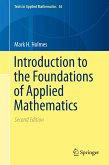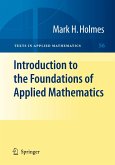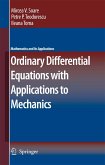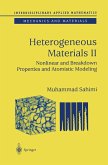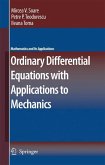The objective of this textbook is the construction, analysis, and interpretation of mathematical models to help us understand the world we live in. Rather than follow a case study approach it develops the mathematical and physical ideas that are fundamental in understanding contemporary problems in science and engineering. Science evolves, and this means that the problems of current interest continually change.
What does not change as quickly is the approach used to derive the relevant mathematical models, and the methods used to analyze the models. Consequently, this book is written in such a way as to establish the mathematical ideas underlying model development independently of a specific application. This does not mean applications are not considered, they are, and connections with experiment are a staple of this book.
The book, as well as the individual chapters, is written in such a way that the material becomes more sophisticated as you progress. Thisprovides some flexibility in how the book is used, allowing consideration for the breadth and depth of the material covered.
Moreover, there are a wide spectrum of exercises and detailed illustrations that significantly enrich the material. Students and researchers interested in mathematical modelling in mathematics, physics, engineering and the applied sciences will find this text useful.
The material, and topics, have been updated to include recent developments in mathematical modeling. The exercises have also been expanded to include these changes, as well as enhance those from the first edition.
Review of first edition:
"The goal of this book is to introduce the mathematical tools needed for analyzing and deriving mathematical models. ... Holmes is able to integrate the theory with application in a very nice way providing an excellent book on applied mathematics. ... One of the best features of the book is the abundant number of exercises found at the end of each chapter. ... I think this is a great book, and I recommend it for scholarly purposes by students, teachers, and researchers."
Joe Latulippe, The Mathematical Association of America, December, 2009
What does not change as quickly is the approach used to derive the relevant mathematical models, and the methods used to analyze the models. Consequently, this book is written in such a way as to establish the mathematical ideas underlying model development independently of a specific application. This does not mean applications are not considered, they are, and connections with experiment are a staple of this book.
The book, as well as the individual chapters, is written in such a way that the material becomes more sophisticated as you progress. Thisprovides some flexibility in how the book is used, allowing consideration for the breadth and depth of the material covered.
Moreover, there are a wide spectrum of exercises and detailed illustrations that significantly enrich the material. Students and researchers interested in mathematical modelling in mathematics, physics, engineering and the applied sciences will find this text useful.
The material, and topics, have been updated to include recent developments in mathematical modeling. The exercises have also been expanded to include these changes, as well as enhance those from the first edition.
Review of first edition:
"The goal of this book is to introduce the mathematical tools needed for analyzing and deriving mathematical models. ... Holmes is able to integrate the theory with application in a very nice way providing an excellent book on applied mathematics. ... One of the best features of the book is the abundant number of exercises found at the end of each chapter. ... I think this is a great book, and I recommend it for scholarly purposes by students, teachers, and researchers."
Joe Latulippe, The Mathematical Association of America, December, 2009
From the reviews:
"This work by Holmes (RPI) is a thorough overview of classical analysis/differential equations-based applied mathematics (not statistics or discrete mathematics). ... This is a wonderful, well-written book that should be in every academic library. Includes many examples, 126 references, and 221 exercises. Summing Up: Highly recommended. Upper-division undergraduates, graduate students, researchers, and faculty." (J. D. Fehribach, Choice, Vol. 47 (8), April, 2010)
"The goal of this book is to introduce the mathematical tools needed for analyzing and deriving mathematical models. ... Holmes is able to integrate the theory with application in a very nice way providing an excellent book on applied mathematics. ... One of the best features of the book is the abundant number of exercises found at the end of each chapter. ... I think this is a great book, and I recommend it for scholarly purposes by students, teachers, and researchers." (Joe Latulippe, The Mathematical Association of America, December, 2009)
"One of the primary objectives of the book is to use mathematics to derive a fundamental understanding of the derivation, analysis and interpretation of mathematical models. ... The book contains a wide spectrum of exercises and detailed illustrations. It addresses students and researchers interested in mathematical modeling in physics, engineering and applied sciences. It can also be recommended as a textbook at the graduate student level." (Iuliana Oprea, Mathematical Reviews, Issue 2011 c)
"Holmes's text ... should be accessible to both mathematicians and science and engineering audiences at the senior or beginning graduate level. ... it establishes the tools of applied mathematics and the underlying concepts of model development independent of a specific application. ... I strongly recommend this book for an introductory senior or graduate level course in applied mathematics." (J.David Logan, SIAM Review, Vol. 52 (1), 2010)
"This work by Holmes (RPI) is a thorough overview of classical analysis/differential equations-based applied mathematics (not statistics or discrete mathematics). ... This is a wonderful, well-written book that should be in every academic library. Includes many examples, 126 references, and 221 exercises. Summing Up: Highly recommended. Upper-division undergraduates, graduate students, researchers, and faculty." (J. D. Fehribach, Choice, Vol. 47 (8), April, 2010)
"The goal of this book is to introduce the mathematical tools needed for analyzing and deriving mathematical models. ... Holmes is able to integrate the theory with application in a very nice way providing an excellent book on applied mathematics. ... One of the best features of the book is the abundant number of exercises found at the end of each chapter. ... I think this is a great book, and I recommend it for scholarly purposes by students, teachers, and researchers." (Joe Latulippe, The Mathematical Association of America, December, 2009)
"One of the primary objectives of the book is to use mathematics to derive a fundamental understanding of the derivation, analysis and interpretation of mathematical models. ... The book contains a wide spectrum of exercises and detailed illustrations. It addresses students and researchers interested in mathematical modeling in physics, engineering and applied sciences. It can also be recommended as a textbook at the graduate student level." (Iuliana Oprea, Mathematical Reviews, Issue 2011 c)
"Holmes's text ... should be accessible to both mathematicians and science and engineering audiences at the senior or beginning graduate level. ... it establishes the tools of applied mathematics and the underlying concepts of model development independent of a specific application. ... I strongly recommend this book for an introductory senior or graduate level course in applied mathematics." (J.David Logan, SIAM Review, Vol. 52 (1), 2010)


